Alberta medicinal and edible herbs
We joined the wonderful Kalyn Kodiak a clinical herbalist, on a Herb walk in Fish Creek Park (Calgary). Here are a few photos and herbs that we found:)
Urtica dioica, Urticaceae family / Stinging Nettle
A herbaceous perennial with a prickly stem and under leaves which release an acrid, skin irritating juice. A special technique is used for picking Nettle to negotiate around the prickles or you can use a good pair of gloves. Nettle has opposite lance shaped to ovate serrated leaves with small green flowers that bloom in the summer. It is common to see Nettle in North American and European meadows and along river and stream banks.
The Leaf, root and seeds of the plant are used as food, medicine and textile fibre. Mostly used as a nutritious green, the stingers will wilt under heat so either dunking the plant in hot water you can add it to soups, omelets, curries etc… Nettle is used commercially for its chlorophyll. Other uses include promoting menses, killing worms, stimulate urination, shrink nasal polyps and to heal infected sores.
Depending on the plant the chemical constituents vary. The roots contains sterols and steryl glycosides, including beta-sitosterol. The roots are also said to contain phenylpropanes, polyphenols, polysaccharides and tannins. The leaves contain some of the same plus flavonol glycosides such as quercitin, as well as carotenoids, chlorophyll, acids, vitamins C, B, and K and minerals ; calcium, magnesium, and potassium.
Nettle is nutritive, alterative, antirheumatic (leaves), prostatic and pelvic decongestant (root) and kidney trophorestorative (seeds)
Trifolium pratense, Fabaceae family/ Red clover
A biennial plant with various stems rising from the same root. Leaves are ternate and leaflets oval, often a lighter color in the center. Flowers are red and fragrant, they are dense, short, ovate, sessile spikes.
Used as an alterative, nutritive and sedative, an expectorant and antispasmodic. Traditionally used to treat whooping cough, skin disease, Mastitis, PMS and menopause. Red clover is said to cleanse the blood and stimulate the liver. Fresh, crushed flowers can be applied to stings and bites.
Chemical constituents include salicylic acid, myricyl alcohol, heptacosane, hentriacontane, sitosterol, isorhamnetin, phenols, glucosides, volatile oil, coumaric acid, tannins, resins, and flavonoids. The blossoms contain phytosterol glycosides; trifolianol, trifolin (C22H22O11), trifolitin (C16H12O6) and in response to viral and fungal infection.
Contraindications: Not to be used during pregnancy as effects on fetus is unknown and not to be given to children under the age of 2. Isoflavones are secreted in the breast milk therefore, A dosage of one to two tablets of the isoflavone standardized product should not be exceeded by lactating women.
White clover, Trifolium repens may have different properties but still considered nutritive and great for teas. (bitter quality)
Achillea millefolium, Asteraceae family / Yarrow
Our dear friend yarrow is a native plant to Alberta, a perennial upright with a woody stem. The composite flower head is an umbel shaped with white, yellow or pinkish flowers. The leaves are finely divided bi and tri- pinnate (thousand leaf) with little hairs. Yarrow has a distinctive odour.
Yarrow is mainly used as a diaphoretic, made as a tea to drink or bath in to sweat out colds, fevers and treat open wounds. A peripheral vasodilator, it is also used for warming cold feet. Yarrow aids in eliminating waste in blood by increasing circulation. An enema or ointment can be made for piles and bowel hemorrhage. The leaves are said to be styptic, helping to stop bleeding. A good example of this is using the furry leaves placing them up the nostril if one has a nose bleed to stop blood flow.
Farmers and gardeners often use yarrow tea to ‘digest’ the compost. A good bee plant, great to pollinate plants and also promotes soil fertility.
Chemical constituents include volitile oils, lactones (achillin, millefin, deacetylmatricarine), resin flavonoids (including luteolin, apigenin, kaempferol and quercitrin), bitters (including the sesquiterpenes; cyanidin) rutin, tannins, coumarins, saponins, sterols, alkanes (tricosane, heptadecane and pentacosane), fatty acids (linoleic, palmatic, oleic acids), alkaloids (achilleine, betaine, trigonelline, betonicine and stachydrine), salicylic acid and sucinic acid, ß- sitosterol, stigmasterol and selenium.
Contraindications : Tea, tincture and essential oil should be avoided during pregnancy, in large doses yarrow is a uterine stimulant. It can be used during pregnancy as a flower essence in a homeopathic 1 – 12 x. The essential oil is contraindicated in pregnancy.
The fine-feather like leaves as shown here are said to be hemostatic; causing bleeding to stop. This plants genus name is drawn from the greek warrior Achilles, who was introduced the plant by his mentor Chiron to heal wounds.
Rose acicularis, Rosaceae family/ Wild Rose
This prickly stem deciduous beauty can be found throughout Alberta and is pictured on our licence plates. The leaves are pinnate with various ovate serrated leaflets. The flowers are often pink, I have added a photo below of a white one here that I guess may be bleached by the sun. Although, there are many species and hybridization. Usually, 5 petals, 5 sepals alternating with 5 bracts and numerous stamens. The successfully pollenated flowers form a fruit referred to as the Rose hip which contains an abundant supply of vitamin C and lycopene.
Rose hips are used to boost the immune system as well as treat colds, flu, and rheumatoid arthritis. They can be prepared into a tea, tincture, soup, jam, jelly, wine etc… although there are little hairs within the fruit which are not comfortable to ingest.
Seeds of hips are rich in Vitamin E and often, with tremendous care made into an oil.
Contraindications: High doses of Vitamin C can potentially lead to kidney stones, severe diarrhea, nausea, and gastritis. It may also interfere with blood thinning agents like Warfarin. Avoid high doses of vitamin C if there is a history of kidney failure or in those taking agents that may damage the kidneys.
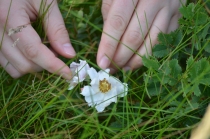
Wild white rose
Barbarea vulgaris, Brassicaceae family / wild mustards
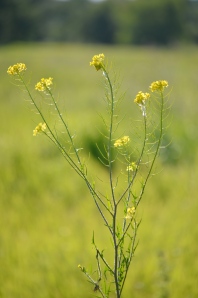
mustard photo by Sarathlal
There is a variety of wild mustard, they are generally tall plant with pinnately divided leaves, yellow flowers and erect ascending pods with a row of seeds. Leaves are dark green and lobed.
This arial parts (above ground) are a zesty/peppery addition to your salad, sandwich or soup and should be used in small quantities. The seeds are traditionally used to make mustard by being ground into a powder and mixed with salt and vinegar. The plants are rich in Vitamin A, B and C and also offer an abundance of trace minerals. The seeds are useful in stimulating digestion. A mustard plaster was traditionally applied on the chest to reduce congestion but this can also irritate the skin. Plants in the Mustard family contain isothiocyanate potentially inhibiting cancer and tumor growth.
WARNING: Powdered mustard seeds can be irritating and essential mustard oil is toxic. Do NOT consume in large amounts as it will cause vomiting and can effect the thyroid causing excessive secretions (hyperthyroidism)
Edible Alberta Berries
Amelanchier alnifolia, Rosacea family/ Saskatoon berry
This shrub has a dark grey bark. Leaves are smooth, oval, toothed on the upper half edges and about 2-5cm long. Flowers are white, forming clusters near branch tips. Fruits form in approximately June or July depending on region and climate and ripen to a deep purple color
Dried saskatoon berries are mixed with meat and fat to make pemmican a traditional aboriginal food. Also, used in soups and stews, this sweet fruit can be used in jellies, jams, muffins, puddings, syrups and wine.
Saskatoon berry juice is said to relieve stomach pain and prepared to make ear and eye drops.
The branches were used in various ways including; to make arrows and tipi pin closures. The berry juice can be used as a purple dye.
*Warning: leaves and pits contain a toxin similar to cyanide. Cooking or drying is recommended to destroy the poison.
Ribes oxyacanthoides. Grossulariaceae family / gooseberry
A shrub with spiny branches. Alternate ‘mapleleaf-shaped’ leaves about 2-5cm wide. Flowers are long and tubular white and/or pale greenish-yellow. Fruits are smooth, purple.
Gooseberries can be eaten Raw, cooked or dried. They make great jams and jellies as they are high in pectin. Rich in vitamin C they can be used to treat colds and sore throats. Also used in a wash to sooth skin after rash and poison ivy exposure. Gooseberry’s and currents can be used as anti-septics. The thorns were traditionally used to apply tattoos, remove slivers and pierce boils.
warning: Eat in moderation as too many can cause stomach pains.

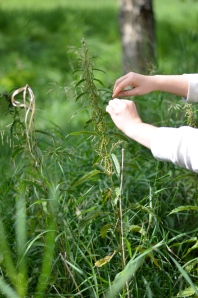
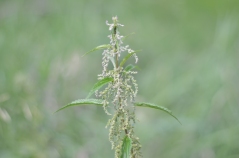
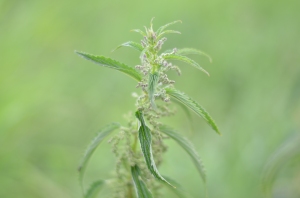
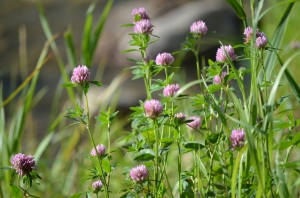
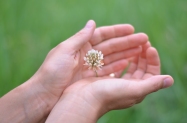
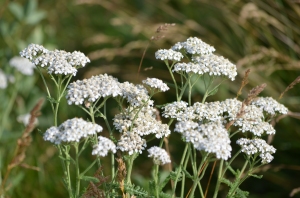
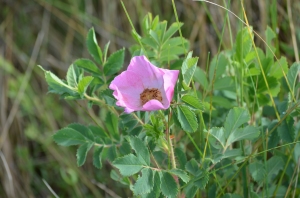

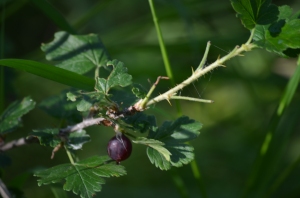
Great article! I like that you were very thorough with your botanical descriptions.